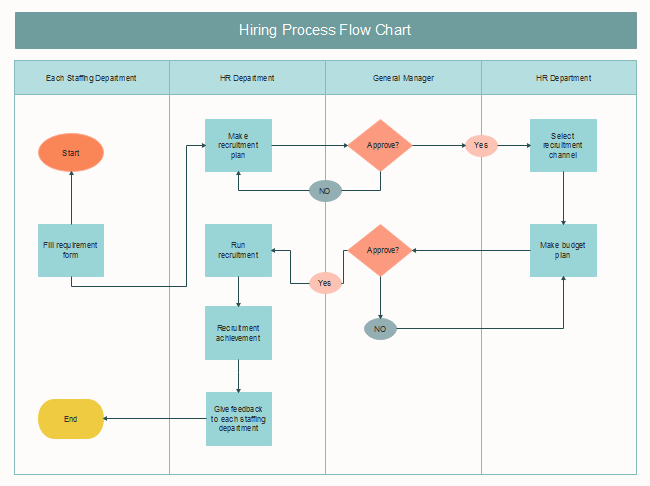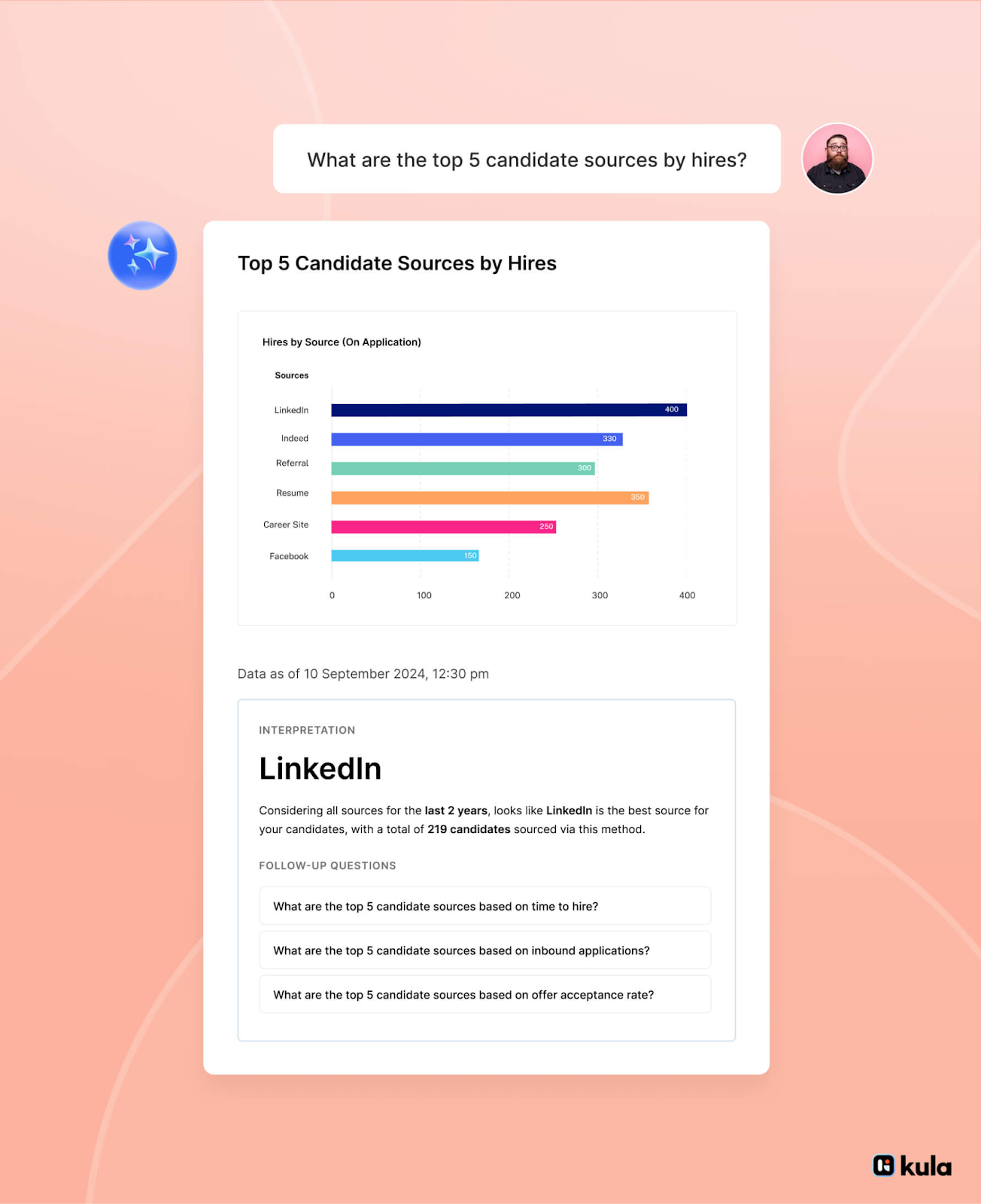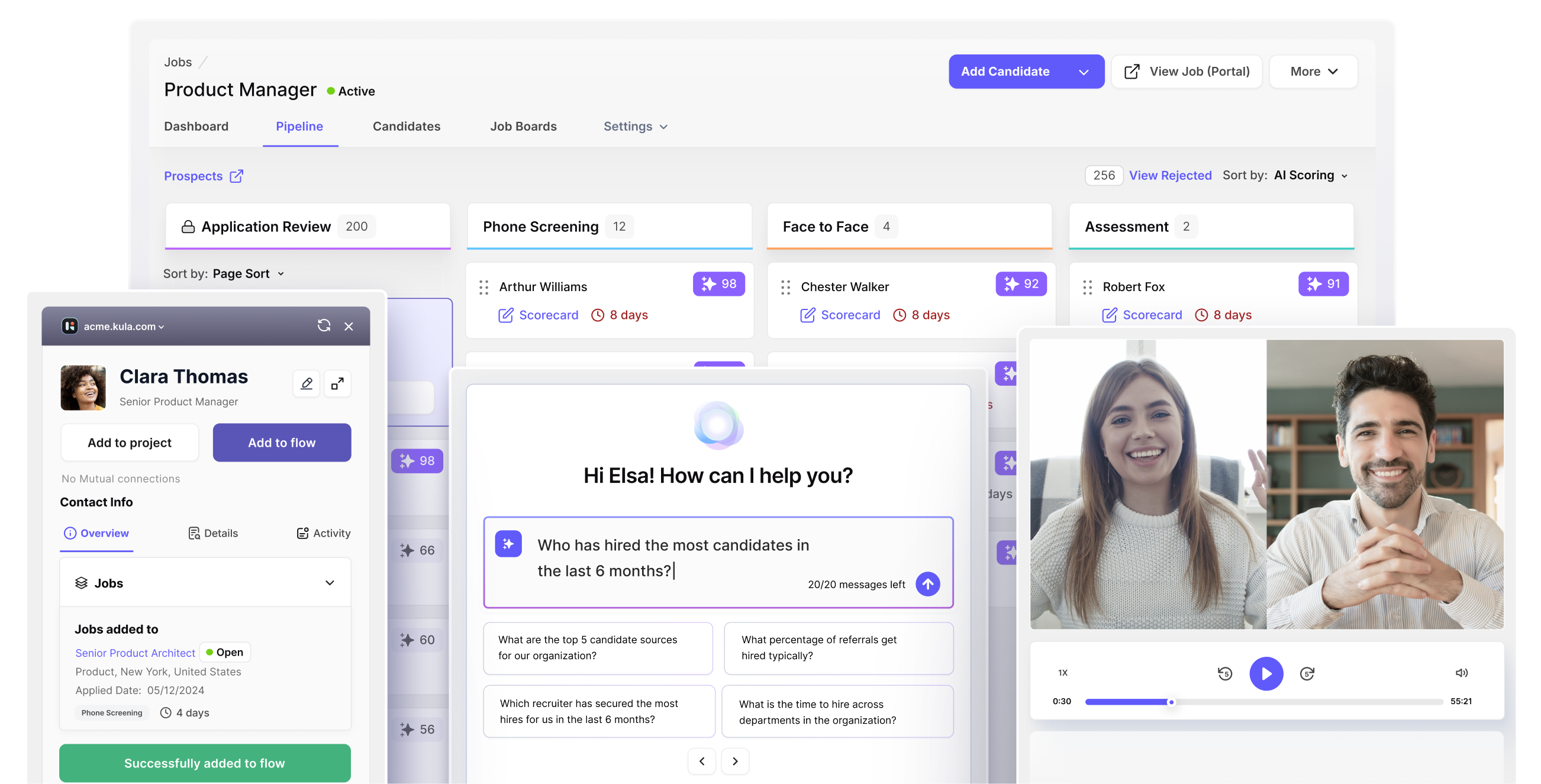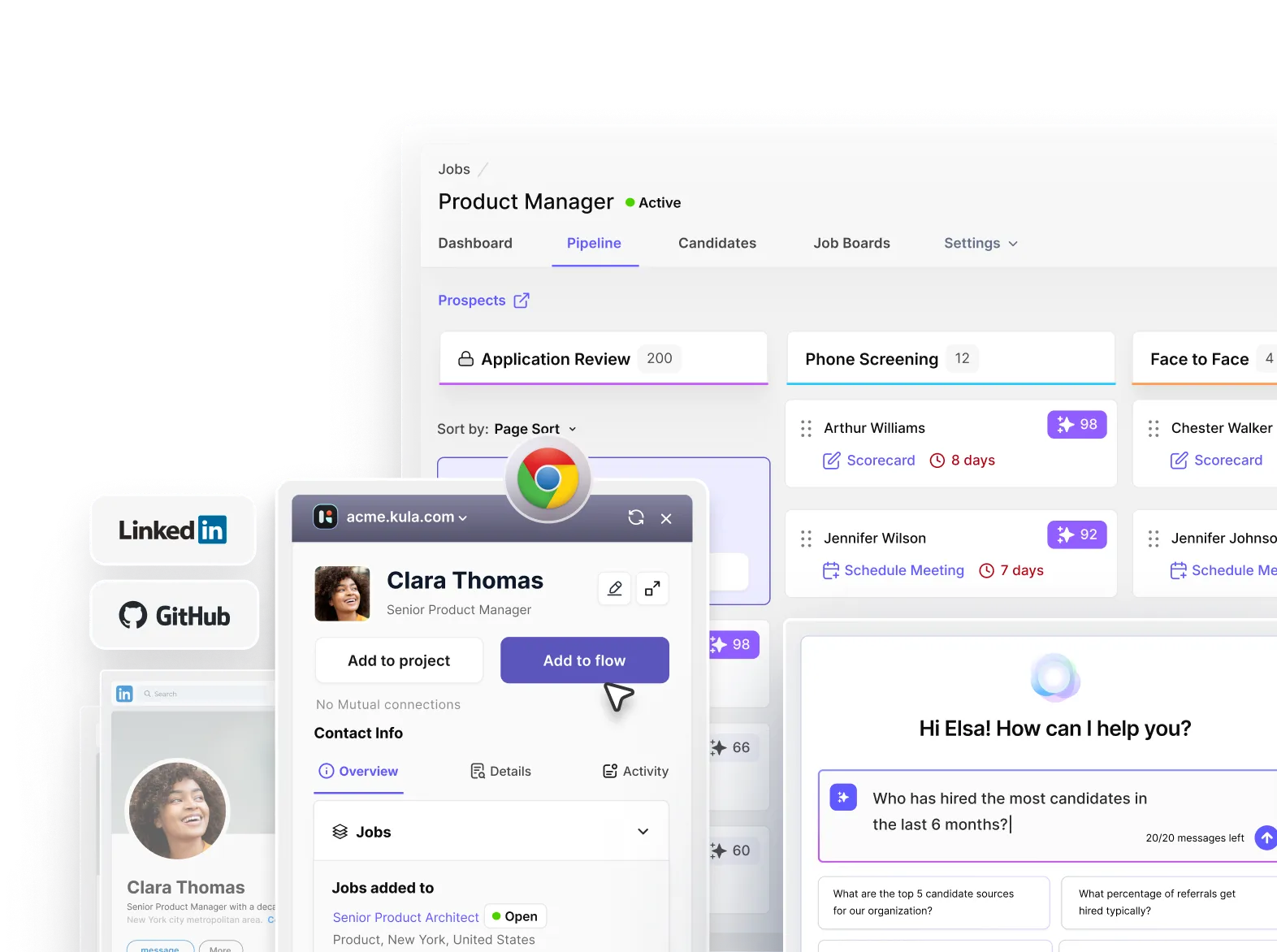Book a 30-minute demo and learn how Kula can help you hire faster and smarter with AI and automation
The backbone of every successful recruitment strategy lies in detailed planning. It helps minimize wasted efforts and ensure optimal resource allocations.
A hiring process flowchart does this exactly. It lays out each hiring step specifically with all the contextual information for teams to carry out the process without any confusion.
The best part? There are no strict rules. You can create a customized flowchart as per your organization's hiring style and team structure.
Even better—it doesn’t take much extra work. As you analyze your hiring process for optimization or setting goals, you can use that information to map out a hiring flowchart for your team.
In this blog, you’ll learn about
- What a hiring flowchart is and why it matters
- How to create one for your team
- Templates to get started
What is a hiring process flowchart, and why is it important?
A hiring process flowchart visually represents the steps your company adopts to reach talent.
This makes it easy for you and your team members to remain on the same page since you can understand a recruitment flowchart at a single glance.

With a flowchart, you can visualize the next steps of your hiring process and make timely adjustments.
It is one of the ways to keep your hiring efforts moving quickly since every hiring team member is informed about each customized step.
Some hiring process flowcharts can be drafted by hand or with tools such as Word or Canva to summarize the entire process.
Here are some of the key benefits of using a hiring process flowchart:
- Clarity on the process: With a detailed hiring process flowchart, you can avoid lengthy conversations and keep team members aligned. You can also add a responsible person for each step in the flowchart for more clarity.
- Maintain consistency: It allows you to build a consistent structure for hiring across your organization to avoid missing crucial steps. This way, every team member remains updated about what needs to be done.
- Helps cut down costs: A hiring process flowchart reduces redundancies and time to hire and ensures effective use of resources with clear communications.
- Legal compliance: Different countries, industries, and states have promulgated laws to guide the recruitment practices of an organization. With a flowchart, you can identify the policies already in place and implement them to get the best results.
How to create a hiring process flowchart: A step-by-step guide
The structure of a hiring process flowchart differs for each organization based on its specific needs.
However, we’ve identified some crucial steps that you can adopt.
1. Identify hiring needs and draft the job description
When drafting a hiring process flowchart, you must identify areas within your organization that need attention.
What specific roles or skills does the general workforce need to improve the overall output of the business?
Afterward, you can reach out to those in the department to identify the responsibilities of the candidate who fills the role.
This allows you to gain an overview of their daily activities, the qualifications required for the job, and the kind of experience you should look for.
Based on this knowledge, you can draft the job description and differentiate core skills from the ones that are nice to have.
Using Kula’s free AI job description generator can help you speed up this process and customize the requirements based on the specific job.
2. Decide sourcing channels (active and passive)
Since top candidates only remain available 10 days before they get hired, you need to adopt proactive measures to source ideal candidates before your competitors find them.
This is why you must consider multiple channels to attract your ideal fit for the vacant roles.
Include channels such as:
- Social media platforms, especially LinkedIn
- Job boards like Indeed, Glassdoor, Craigslist, etc
- Employee referral programs
- Job advertisements
- Campus recruitment events
- Job fairs
You can use Kula AI Analytics to measure the effectiveness of each sourcing channel you use. It provides conversational search features that allow you to extract insights with a simple chat.

With its integration with LinkedIn Recruiter System Connect (RSC), you can link all activities on the professional platform to unify efforts.
3. Analyze the screening and assessment process
The screening stage is key in the recruitment process because it helps you measure candidates against the predetermined criteria.
This way, you can avoid wasting time on candidates without the right skills, attitude, and experience for the job.
Here are some interesting ways to go about screening your candidates:
- Review resumes to identify employment gaps and the candidate’s attention to detail. With Kula ATS, you can use the automatic resume parsing feature to speed up this process.
- Check the social media profiles of candidates to ensure your candidates fit into your company’s values. You can use Kula ATS to export LinkedIn profiles in a single click to ease the screening stage.
- Use the Kula AI score to straight away focus on top candidates.
4. Optimize your interview process
Suzie Price, Managing Principal and CEO of Priceless Professional Development, asserts that “Faulty hiring is the silent killer of corporate profitability.”
She expands to identify assumptions, excessive focus on background, and eliciting rehearsed answers from candidates as challenges in the interview process.
When interviewing a candidate, you must ensure that the questions and requirements are structured to give everyone an equal opportunity.
Use these techniques to boost the effectiveness of your interviews:
- Draft interview questions beforehand while considering your recruiting goals. Make sure to categorize each question based on the skills and behavior needed.
- Respect the candidate’s time and create a good impression of your company through your introduction.
- Use Kula AI interview note-taker to transcribe conversations for easy reference in the future.

- Make candidates comfortable enough to ask questions about your company.
5. Perform tests and assessments
According to a survey by Checkster, 78% of job seekers lie on their resumes, this is why tests are necessary to find the truth.
After interviewing your top applicants, the next step is to perform tests and assessments to become better informed about the stranger you are assessing.
James Brook, CEO of TalentPredix, said, “If they are using the right metrics or psychological assessments, essentially what it is doing is helping make better decisions, reducing risks, and ultimately you know your candidates better when they join.”
Here are some tips to help you create ideal tests:
- Eliminate all inherent biases from the tests to ensure it is well-updated and inclusive.
- Decide what type of tests your company needs, whether work samples, cognitive ability tests, behavioral tests, or job trials.
- Reevaluate the potency of the tests you create to suit changing times.
- Give candidates clear instructions to tackle the tests to enhance their overall experience.
6. Run reference and background checks
Reference and background checks help you validate claims, assess soft skills, and gain deeper insights into the eligibility of your candidates to do great work.
It allows you to combine details from public records and recommendations from past employers to understand candidates better.
This way, you can prevent yourself from making costly mistakes by hiring the wrong person.
Here are some tips to consider when checking:
- Ensure legal compliance based on your state’s laws and request for a candidate's consent.
- Prepare thoughtful questions for references to aid the decision-making process.
- Schedule a convenient time to run the appropriate checks.
- Review the reports you gather to inform your decision.
7. Make a job offer and onboard
At this stage, you want to ensure that your job offer is irresistible to make sure you successfully onboard most of your eligible candidates.
Once you are sure a candidate is suitable for your organization, quickly inform them and prepare the necessary documents to help them ease into the job.
Here are some practical ways to speed up the job offer and onboarding process with Kula ATS:
- Use Kula ATS to build a library of offer letter templates based on specific criteria.
- Create approval chains for offer letters to allow approvers to accept or decline via email.
- Send offer letters as attachments or via DocuSign so you can easily monitor the signature process on the Kula platform.
- Track and manage the offer process using Kula ATS to view each stage
Types of hiring process flowcharts that different organizations use
1. Linear hiring process flowchart
With this type of hiring process flowchart, you can view events sequentially, right from start to finish.
This is the most common format for creating a flowchart because it allows you to know the next step. However, it fails to account for repeated steps in the hiring process.
2. Department-specific flowchart
A department-specific flowchart shows hiring steps as per each department’s unique hiring needs, role requirements, and internal workflows.
3. Parallel hiring process flowchart
With a parallel hiring process flowchart, you can break down the process into smaller tasks. It is best for teams that are performing different hiring activities at the same time.
4. Collaborative hiring process flowchart
This flowchart highlights the involvement of multiple stakeholders (HR, hiring managers, team leads) at different steps. The major drawback of this approach is that it can be confusing.
Hiring process flowchart templates for 2025
Here, you will find easily downloadable and customizable templates you can use to create a hiring process flowchart for your organization.
1. Hiring process flowchart by Someka

This template is available as a PDF, Excel, or Google sheet to ensure easy access. It allows you to add additional stages to avoid being limited. This way, you can structure it based on the specific needs of your organization.
Download here.
2. Staffing process flowchart by Piktochart

Piktochart provides a visually appealing design for you to outline all your hiring stages and include all the necessary resources you would need. This platform provides all the design tools to customize this flowchart based on your preferences.
Click here to download.
3. Flowchart template by VisualParadigm

Using VisualParadigm enhances collaboration while customizing this template to ensure your team members are updated. You can also export the file in numerous formats when the customization is done.
Download here.
Enhance your hiring process with Kula ATS
Tracking every stage of the hiring process can be quite taxing, but with a detailed flowchart, you can get a clear roadmap.
However, you should mostly automate these hiring steps to reach your top candidates before your competitors do.
With Kula ATS, you can organize your hiring process better, eliminate grunt work, and help hiring team members focus better on the crucial aspects of recruitment. Book a customized demo today to see it for yourself!






















